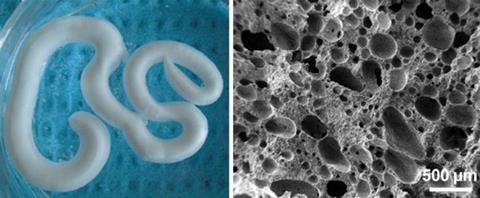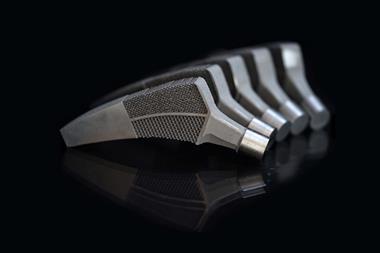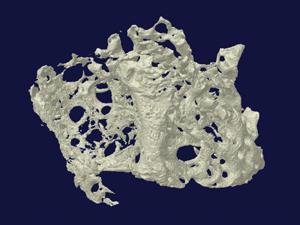Scientists say biomaterial could treat bone defects and diseases
French researchers have developed a self-setting injectable macroporous foam for repairing bone and assisting its growth. It could help regenerate bone faster than other materials while offering a quick and minimally invasive way for surgeons to perform bone repair procedures, and possibly treat osteoporosis.

With 70% of bone consisting of a calcium phosphate mineral called hydroxyapatite, calcium phosphate cements (CPCs) are widely used in surgery as bone substitutes. CPCs have excellent properties for the job – they are injectable, biocompatible, self-setting and microporous allowing nutrients to flow throughout the implant site, which assists bone regeneration.
However, it’s been a challenge introducing macroporosity into such injectable CPCs, which is desirable to facilitate quicker bone regeneration and reinforce cancellous bone; the flexible and spongy tissue that degenerates with osteoporosis. Macroporous CPCs do exist but those that are injectable have poor mechanical properties.
Now Pierre Weiss and colleagues at the University of Nantes have created a macroporous self-setting CPC in the form of an injectable foam by using a silanised-hydroxypropyl methylcellulose (Si-HPMC) hydrogel as a foaming agent. ‘Our approach is simple and gives us really good results in terms of mechanical properties and macroporous structures,’ says Weiss.
Bubbles with benefits
Previously, the team had attempted to improve the mechanical properties CPC by adding a Si-HPMC hydrogel. But during the process of preparing the Si-HPMC hydrogel with an acidic buffer using syringes – which lowers the pH of the solution causing it to self-cross link and gel – air bubbles appeared in the mixture and they were hard to remove. But Weiss’ postdocs Jingtao Zhang and Weizhen Liu wondered if this drawback might be useful for giving macroporosity to CPC and so they set out to develop a CPC foam.
The team made the foam by putting Si-HPMC and CPC solutions in separate syringes, and then pumping air into the CPC syringe. Both syringes were then joined by a connector and plunged to rapidly mix the solutions and air, which formed a homogenous foam.
‘We knew that both biomaterials are biocompatible separately but we didn’t know how the body would react with a combination of both,’ explains Weiss. To find an answer, and also to test the biofunctionality of the foam, they conducted preliminary in vivo tests by making tiny defects in the thigh bones of two live rabbits and injected the foam into the cavities.
Analyses revealed no toxic effects and that new bone had formed in the central area of the implant sites, suggesting that the CPC foam could be a feasible and effective material for treating certain bone defects and diseases. ‘We think this could be a good biomaterial, perhaps with active molecules, to act against osteoporosis locally. We need to determine the proof of concept in animal models,’ adds Weiss.
‘There are quite a few groups working on this issue and different solutions proposed. This could be one, the preliminary results are very interesting.’ says Eduardo Saiz, who investigates biomaterials for bone repair at Imperial College, London, UK. ‘If the research progresses well it could give surgeons an easy to use material for minimally invasive procedures, which will benefit clinical practice.’
References
J Zhang et al, Acta Biomater., 2015, DOI: 10.1016/j.actbio.2015.11.055












No comments yet